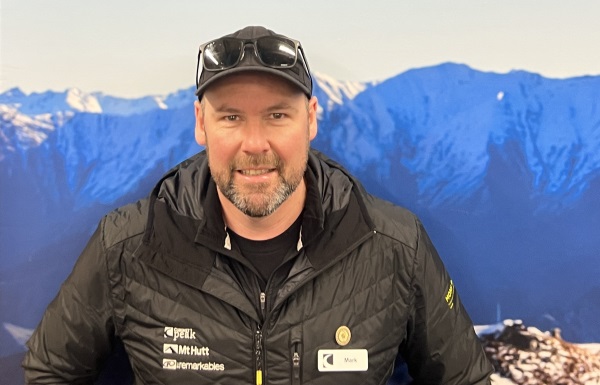Like many intending to pass through Queenstown, Scotsman Mark Sommerville fell in love with the mountains and hasn’t managed to
escape their grip yet. Now Coronet Peak’s assistant ski area manager, he talks to LUCY WORMALD about getting a mountain education, kaitiakitanga, and the future of the skifield ahead of its 75th anniversary
In 2006, Mark Sommerville landed in Queenstown kitted with nothing but a backpack, intending to spend three weeks here.
The Scotsman had been travelling around Australia for several months before falling in with a group of like-minded friends who were heading across the ditch to pick up winter work in the resort.
‘‘They had all kind of pre-planned their ski season and all had jobs within NZSki before I decided to join them for three weeks.
‘‘When I arrived, I learned that they were looking for ticket scanners to check people’s lift passes with the old barcode scanners … so I came on board,’’ Sommerville says.
With only six days of skiing experience under his belt, he jumped headfirst into working on the slopes of Coronet Peak.
‘‘My dad was a physical trainer in the army so I got exposed to skiing at a young age, maybe four or five years old.
‘‘I was a beginner intermediate when I first got here and found the bug for it,’’ he says.
A natural with the barcode scanner, Sommerville was asked to stay on in the role, so he can celled his ticket home and settled in for what would be the first of many seasons at Coronet.
He then got approached by a guy from the United States offering winter work in Vermont, so spent a season there as a lift operator, returning to Coronet after that for another winter.
‘‘And I’ve been here ever since on a full-time contract.’’
While his initial forte was lifts — he was an operator, before becoming team leader and then head of department — he became maintenance manager in 2010, then stepped up to operations manager, and was appointed assistant ski area manager in ’13.
He says he joined the Coronet family at a time when the investment going into the mountain meant year-round work, and the opportunity to develop a broad skillset.
‘‘Having a job in a skifield is very much like having a job in a farm, you’ve got to be able to do lots of different tasks, you’ve got to have lots of different skillsets, many of which I didn’t have at the time.’’
Being involved with projects and maintenance, particularly the wave of development in the late 2000s, like the new base building, chairlifts, snow guns, and reservoirs, meant he was constantly developing practical skills.
Now in his 17th season at Coronet, Sommerville’s expertise is complemented by a fierce sense of guardianship over the mountain.
‘‘This feels like home to me.
‘‘I’ve really loved growing up on the mountain … and really taking my role of kaitiaki on the mountain very seriously.’’
A highlight of the role has been bringing native birds back to the alpine environment.
‘‘Karearea, New Zealand’s only native raptor, used to frequent up here.
‘‘We haven’t really seen that many over the last few years, so a renewal of the vegetation up here, their nesting grounds, and also installing trap lines along the perimeter of the mountain enables the karearea to return.’’
And, as NZSki turns its attention towards a sustainable and resilient tourism future, he believes there’s an opportunity to vanguard real change.
‘‘One of our strengths is being three mountains [Coronet, The Remarkables and Mt Hutt], and being able to collaborate and work in the NZ ski industry.
‘‘The different snow reports from NIWA and the global snow reports are not that encouraging, so relying on Coronet Peak to be a winter-only destination, given the asset base that we have, just doesn’t make sense,’’ he says.
The next step for the mountain is becoming a year-round destination, extending the window that visitors can enjoy Coronet from four months to most of the year, he says.
‘‘We’ve been skiing and mountain biking at Coronet for three or four years, turning Coronet Peak into a summer destination for both recreation and tourism.
‘‘It’s always been a recreational hotspot, we’ve always had skiers, and then hikers and dog walkers up here in the summer, but now that we’ve opened the chairlifts [in the summer] we’re seeing a lot more tourism.’’
For Sommerville, that means the best part of his job — meeting the people who visit and return to the mountain year-on-year — is only set to get better.
‘‘[It’s] just being part of a larger group of people that our role is to facilitate people having fun and that’s essentially what I try to do, is to
facilitate our crew to be able to give our guests a good time up here.’’




